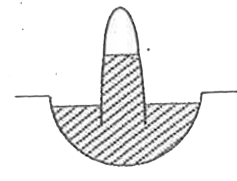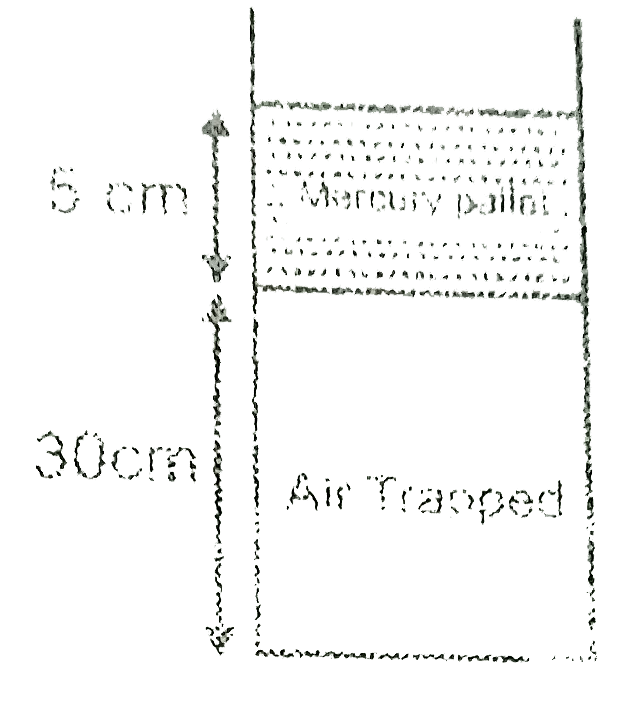A barometer tube is 80 cm long (above the mercury reservoir). It reads 76 cm in a particular day. A small amount of water is introduced in the tube and the reading drops to 75.4 cm. Find the relative humidity in the space above the mercury column if the saturation vapor pressure at the room temperature is 1.0cm.
To solve the problem, we need to analyze the situation using the concept of atmospheric pressure, vapor pressure, and relative humidity.
Step 1: Understand the Initial Conditions
Initially, the barometer reads 76 cm of mercury. This means that the atmospheric pressure (P_atm) is equivalent to the height of the mercury column, which is 76 cmHg.
Step 2: Analyze the Situation After Adding Water
After adding a small amount of water, the barometer reading drops to 75.4 cmHg. This indicates that the pressure exerted by the atmosphere is now equal to the height of the mercury column plus the vapor pressure of the water introduced.
Step 3: Set Up the Equation
We can express the atmospheric pressure before and after adding water as follows:
1. Before adding water:
Patm=76cmHg
2. After adding water:
Patm=75.4cmHg+Pvapor
Where Pvapor is the vapor pressure of the water in the tube.
Step 4: Solve for Vapor Pressure
From the two equations, we can equate them:
76cmHg=75.4cmHg+Pvapor
Now, we can solve for Pvapor:
Pvapor=76cmHg−75.4cmHg=0.6cmHg
Step 5: Calculate Relative Humidity
Relative humidity (RH) is defined as the ratio of the actual vapor pressure to the saturation vapor pressure, expressed as a percentage:
RH=(PvaporPsaturation)×100
Given that the saturation vapor pressure at room temperature is 1.0 cmHg, we can substitute the values:
RH=(0.6cmHg1.0cmHg)×100=60%
Final Answer
The relative humidity in the space above the mercury column is 60%.
---
Initially, the barometer reads 76 cm of mercury. This means that the atmospheric pressure (P_atm) is equivalent to the height of the mercury column, which is 76 cmHg.
After adding a small amount of water, the barometer reading drops to 75.4 cmHg. This indicates that the pressure exerted by the atmosphere is now equal to the height of the mercury column plus the vapor pressure of the water introduced.
We can express the atmospheric pressure before and after adding water as follows:
Patm=76cmHg
Patm=75.4cmHg+Pvapor
Where Pvapor is the vapor pressure of the water in the tube.
From the two equations, we can equate them:
76cmHg=75.4cmHg+Pvapor
Now, we can solve for Pvapor:
Pvapor=76cmHg−75.4cmHg=0.6cmHg
Relative humidity (RH) is defined as the ratio of the actual vapor pressure to the saturation vapor pressure, expressed as a percentage:
RH=(PvaporPsaturation)×100
Given that the saturation vapor pressure at room temperature is 1.0 cmHg, we can substitute the values:
RH=(0.6cmHg1.0cmHg)×100=60%
The relative humidity in the space above the mercury column is 60%.
Topper's Solved these Questions
Similar Questions
A barometer correctly reads the atmospheric pressure as 76cm of mercury. Water droplets are slowly introduced into the barometer tube by a dropper. The height of the mercury column first decreases and then become constant. If the saturation vapour pressure at the atmospheric temperature is 0.80cm of mercury, find the height if the mercury column when it reaches its minimum value.
View SolutionA mercury barometer reads 75cm. Now 3cm3 of atmospheric air is introduced into the tube. The mercury falls to a height of 65 cm and the length of air column above the mercury is found to be 15 cm Calculate the cross-sectional area of the barometer tube.
View SolutionA barometer tube is 1 m long and 2cm2 in cross section. Mercury stands to a height of 75cm in the tube. When a small amount of oxygen is introduced in the space above the mercury level, the level falls by 5cm. Calculate the mass of the oxygen is introduced. Room temperature=27∘C, g=10 m s_(-2)anddensityifmercury=13600kg m^(-3).
View SolutionA barometer tube reads 76 cm of mercury. If the tube is gradually inclined at an angle of 60 with vertical, keeping the open end immersed in the mercury reservoir, the length of the mercury column will be
View SolutionA barometer reads 75cm if mercury. When 2.0cm3 of air at atmospheric pressure is introduced into space above the mercury level, the volume of this space cecones 50cm3. find the length by which the mercury column desecds.
View SolutionA barometer tube reads 76 cm of mercury. If the tube is gradually inclined keeping the open end immersed in the mercury reservoir, will the length of mercury column be 76 cm, more than 76 cm or less than 76 cm?
View SolutionA faulty barometer contains certains amount of air and saturated water vapour . It reads 74.0cm when the atmospheric pressure is 76.0cm of mercury and reads 72.10cm when the atmospheric pressure is 74.0cm of mercury.Saturation vapour pressure at air temperature =1.0cm of mercury. Find the length of the baromerer tube above the mercury level in the reservoir.
View SolutionThe mercury manometer consists if two unequal arms of equal cross section 1 cm^(2) and lenghths 100cm and 50cm. The two open ends are sealed with air in the tube at a pressure of 80cm of mercurey. Some amount of mercury is now introduced in the manometer through the stopcock connected to it. If mercury rises in the shorter tube to a lenght 10cm in steady state, find the length of the mercury column risen in the longer tube.
View SolutionTorricelli was the first do devise an experiment for measuring atmospheric pressure . He took calibrated hard glass tube , 1 m in lengt and of uniform cross section , closed at one end . He filled the whole tube with dry mercury taking care than no air or water droplets remain inside the tube , closed the opposite end of the tube tightly with thumb and inverted it . He put this inverted mercury tube into a mercury through , taking care that the end of the tube remains inside the mercury through , An interesting thing was noticed . Mercury in the tube fell down at first and then stopped at a particular position . The height was 76 cm above the free surface of mercury in the through . When the given tube was inclined or lowered in the mercury trough , the vertical haight of mercury level in the tube was always found constant .
Torricelli explained this by saying that the free surface of mercury in the trough . Hence , the hydrostatic pressure exerted by the trough measures the atmospheric pressure .

If this expriment uses water instead of mercury , then
A. length of water will be equal to 76 cm
B. length of water will be less than 76 cm
C. length of water will be greater than 76 cm
D. none of the aboveView SolutionIn given figure, A uniform cylindrical tube closed at one end, contains a pallet of mercury 5cm long. When the tube is kept verticaly with the closed end downward, the length of the air column trapped is 30cm. Now the tube is inverted so that the closed end goes up find the new length of the air column trapped. atmospheric pressure =75cm of mercury. (Assume temperature remains constant in this process)
 View Solution
View Solution

